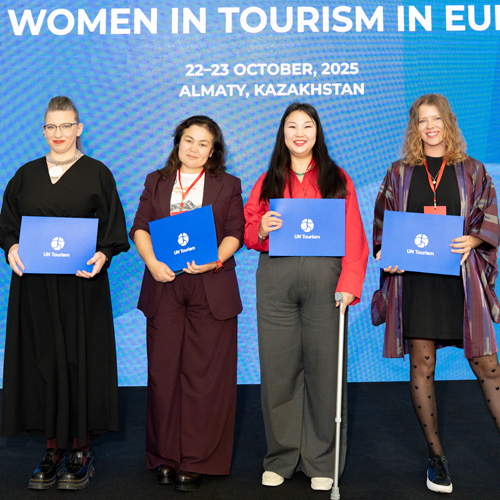Iraq National Consultation Report: Aligning Social Development with Sustainable Development Goals for WSSD2
1.0 Executive Summary
A national consultation was conducted in Baghdad on 20–21 October 2025, convened by the Government of Iraq and the United Nations. The primary objective was to formulate a unified national vision for the Second World Summit for Social Development (WSSD2). The consultation focused on strengthening Iraq’s social protection systems as a critical driver for achieving the Sustainable Development Goals (SDGs), particularly those related to poverty, inequality, decent work, and institutional strength. The outcomes will guide the Iraqi delegation in presenting its progress and commitments at the global summit.
2.0 Stakeholder Collaboration and Partnerships for the Goals (SDG 17)
The event demonstrated a multi-stakeholder partnership approach, crucial for implementing the 2030 Agenda. Key participants included:
- Government of Iraq: Led by the Ministry of Planning, with representation from the Ministries of Labour and Social Affairs, Foreign Affairs, Education, Youth and Sports, and Environment.
- United Nations: Coordinated by the UN Resident Coordinator’s Office, with technical support from the World Food Programme (WFP), the International Labour Organization (ILO), and the United Nations Children’s Fund (UNICEF).
- International Partners: The European Union, a key supporter of social protection reform in Iraq.
3.0 Strategic Commitments and Progress on Sustainable Development Goals
The consultation culminated in a set of commitments that reinforce Iraq’s progress on several SDGs. These commitments are built upon recent national achievements in social reform.
- Eradicating Poverty and Reducing Inequality (SDG 1 & SDG 10): Iraq has advanced its commitment to SDG 1 (No Poverty) by expanding social safety nets to cover over 7.6 million people. The national vision emphasizes inclusion, with a focus on children, women, persons with disabilities, and other vulnerable groups, directly addressing the targets of SDG 10 (Reduced Inequalities).
- Promoting Decent Work and Economic Growth (SDG 8): Significant legal and institutional reforms underscore Iraq’s dedication to SDG 8. Key achievements include the ratification of ILO Convention No. 102 and the enactment of a new Pensions and Social Security Law aligned with international standards, which has contributed to a doubling of social security coverage in four years.
- Advancing Gender Equality and Youth Empowerment (SDG 5 & SDG 4): The national vision explicitly targets the expansion of opportunities for youth and women, aligning with SDG 5 (Gender Equality) and contributing to targets within SDG 4 (Quality Education) and SDG 8 concerning youth employment.
- Ensuring Peace, Justice, and Strong Institutions (SDG 16): The overarching goal is to strengthen national institutions to serve all citizens effectively and promote social justice, a core principle of SDG 16. This reflects a commitment to building a resilient and equitable society.
4.0 Forward Outlook: Iraq’s Contribution to Global Social Development
Iraq is positioned to present a robust and unified vision at the WSSD2. The summit provides a platform to showcase its rights-based reform agenda and its direct contributions to the global SDGs. A key engagement will be a high-level side event on 4 November 2025, titled “From Reform to Impact: Governments Paving a New Era of Universal Social Protection for Food Security and Nutrition.” This event, led by Iraq, will highlight the critical link between social protection systems and the achievement of SDG 2 (Zero Hunger), leveraging the nation’s extensive experience with large-scale food distribution systems as a foundation for sustainable development.
SDGs, Targets, and Indicators Analysis
1. Which SDGs are addressed or connected to the issues highlighted in the article?
The article highlights several issues that directly connect to a range of Sustainable Development Goals. The analysis below details the relevant SDGs based on the article’s focus on social protection, poverty, inclusion, and institutional reform in Iraq.
-
SDG 1: No Poverty
This is a central theme, as the article explicitly states that advancing “universal social protection” is a “cornerstone for the eradication of poverty” and highlights Iraq’s major reforms in “poverty reduction.”
-
SDG 2: Zero Hunger
The article connects social protection with food security. It mentions Iraq’s experience with a “large food distribution system” and a planned high-level event titled “Universal Social Protection for Food Security and Nutrition,” indicating a direct link to ensuring people have access to food.
-
SDG 5: Gender Equality
The article mentions that Iraq’s national vision “expands opportunities for youth and women” and that the new social protection vision has a specific focus on “women” as a vulnerable group, connecting the reforms to the empowerment of women.
-
SDG 8: Decent Work and Economic Growth
The involvement of the International Labour Organization (ILO), the “ratification of ILO Convention No. 102,” and the new “Pensions and Social Security Law aligned with international standards” all point directly to efforts to improve labour rights and social security for workers.
-
SDG 10: Reduced Inequalities
The core of the article is about promoting “inclusion” and “social justice.” The efforts to strengthen the social protection system are specifically aimed at vulnerable groups, including “children, women, persons with disabilities,” which is a key aspect of reducing inequality.
-
SDG 16: Peace, Justice and Strong Institutions
The article discusses Iraq’s commitment to “rights-based reform” and a national vision that “strengthens institutions to serve all citizens.” This reflects the goal of building effective and accountable institutions.
-
SDG 17: Partnerships for the Goals
The entire initiative described is a multi-stakeholder partnership. The article details the collaboration between the “Government of Iraq,” various “United Nations” agencies (WFP, ILO, UNICEF), and “the European Union,” showcasing a partnership approach to achieving social development.
2. What specific targets under those SDGs can be identified based on the article’s content?
Based on the issues discussed, several specific SDG targets can be identified as being directly addressed by Iraq’s efforts.
-
Under SDG 1 (No Poverty):
- Target 1.3: Implement nationally appropriate social protection systems and measures for all, including floors, and by 2030 achieve substantial coverage of the poor and the vulnerable.
- This is the most prominent target, evidenced by the focus on strengthening “Iraq’s social protection system,” advancing “universal social protection,” the “expansion of social safety nets,” and the “new Pensions and Social Security Law.”
- Target 1.3: Implement nationally appropriate social protection systems and measures for all, including floors, and by 2030 achieve substantial coverage of the poor and the vulnerable.
-
Under SDG 2 (Zero Hunger):
- Target 2.1: By 2030, end hunger and ensure access by all people, in particular the poor and people in vulnerable situations… to safe, nutritious and sufficient food all year round.
- This is supported by the planned event on “Universal Social Protection for Food Security and Nutrition” and the mention of Iraq’s “large food distribution system” as a foundation for its reforms.
- Target 2.1: By 2030, end hunger and ensure access by all people, in particular the poor and people in vulnerable situations… to safe, nutritious and sufficient food all year round.
-
Under SDG 8 (Decent Work and Economic Growth):
- Target 8.8: Protect labour rights and promote safe and secure working environments for all workers.
- The “ratification of ILO Convention No. 102” and the new “Pensions and Social Security Law aligned with international standards” are direct actions toward this target.
- Target 8.8: Protect labour rights and promote safe and secure working environments for all workers.
-
Under SDG 10 (Reduced Inequalities):
- Target 10.2: By 2030, empower and promote the social, economic and political inclusion of all, irrespective of age, sex, disability, etc.
- The article’s emphasis on a vision that focuses on “children, women, persons with disabilities, and other vulnerable groups” directly aligns with this target.
- Target 10.4: Adopt policies, especially fiscal, wage and social protection policies, and progressively achieve greater equality.
- The entire discussion revolves around strengthening “social protection” policies, including “social safety nets” and social security laws, as a means to achieve greater equality.
- Target 10.2: By 2030, empower and promote the social, economic and political inclusion of all, irrespective of age, sex, disability, etc.
-
Under SDG 16 (Peace, Justice and Strong Institutions):
- Target 16.6: Develop effective, accountable and transparent institutions at all levels.
- This is reflected in the national vision to “strengthen institutions to serve all citizens.”
- Target 16.6: Develop effective, accountable and transparent institutions at all levels.
-
Under SDG 17 (Partnerships for the Goals):
- Target 17.16: Enhance the Global Partnership for Sustainable Development, complemented by multi-stakeholder partnerships.
- The consultation itself, being a partnership between the “Government of Iraq,” the “United Nations” (WFP, ILO, UNICEF), and the “European Union,” is a clear example of this target in action.
- Target 17.16: Enhance the Global Partnership for Sustainable Development, complemented by multi-stakeholder partnerships.
3. Are there any indicators mentioned or implied in the article that can be used to measure progress towards the identified targets?
The article provides both quantitative and qualitative indicators that can be used to measure progress towards the identified targets.
-
Quantitative Indicators:
- Number of beneficiaries of social safety nets: The article explicitly states the “expansion of social safety nets to over 7.6 million people.” This is a direct quantitative measure for Target 1.3.
- Rate of increase in social security coverage: The article mentions a “doubling of social security coverage within four years,” which serves as a performance indicator for the expansion of the social protection system under Target 1.3.
-
Qualitative/Policy-based Indicators:
- Implementation of new laws and policies: The article points to the “new Pensions and Social Security Law aligned with international standards” as a key achievement. The existence and alignment of this law is an indicator of progress for Targets 1.3, 8.8, and 10.4.
- Ratification of international conventions: The “ratification of ILO Convention No. 102” is a significant policy-level indicator that demonstrates commitment to international labour and social security standards, relevant to Target 8.8.
- Establishment of multi-stakeholder partnerships: The article details the specific partners involved in the national consultation (Government of Iraq, UN agencies, EU). The formation and functioning of this partnership is an indicator for Target 17.16.
4. Create a table with three columns titled ‘SDGs, Targets and Indicators” to present the findings from analyzing the article. In this table, list the Sustainable Development Goals (SDGs), their corresponding targets, and the specific indicators identified in the article.
| SDGs | Targets | Indicators |
|---|---|---|
| SDG 1: No Poverty | 1.3: Implement nationally appropriate social protection systems and measures for all… and achieve substantial coverage of the poor and the vulnerable. |
|
| SDG 2: Zero Hunger | 2.1: End hunger and ensure access by all people… to safe, nutritious and sufficient food all year round. |
|
| SDG 8: Decent Work and Economic Growth | 8.8: Protect labour rights and promote safe and secure working environments for all workers. |
|
| SDG 10: Reduced Inequalities | 10.2: Empower and promote the social, economic and political inclusion of all.
10.4: Adopt policies, especially… social protection policies, and progressively achieve greater equality. |
|
| SDG 16: Peace, Justice and Strong Institutions | 16.6: Develop effective, accountable and transparent institutions at all levels. |
|
| SDG 17: Partnerships for the Goals | 17.16: Enhance the Global Partnership for Sustainable Development, complemented by multi-stakeholder partnerships. |
|
Source: reliefweb.int

![Iraq and the United Nations Advance Key Commitments to Strengthen Social Protection Ahead of the Second World Summit for Social Development (WSSD2) [EN/AR] – ReliefWeb Iraq and the United Nations Advance Key Commitments to Strengthen Social Protection Ahead of the Second World Summit for Social Development (WSSD2) [EN/AR] – ReliefWeb](https://reliefweb.int/sites/default/files/styles/large/public/previews/f0/99/f0992c50-9b1d-40c1-a3e1-dd75e333c505.png)





